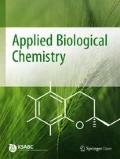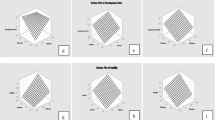Abstract
Effects of various xylanase treatments applied at different stages of bread making process on dough rheological characteristics and bread quality attributes were investigated. Different doses (200, 400, 600, 800, and 1000 IU) of purified enzyme were applied at two stages (tempering and mixing). In milling and dough making processes, both types of flour (subjected to enzyme treatment during tempering and flour mixing) exhibited decreasing trend in water absorption, dough development time, dough stability, softening of dough, dough mixing time, viscosity peak, set back, and increasing tendency in peak height and pasting temperature. Treatments during tempering resulted in more significant effects as compared to applications during flour mixing. The dough rising during proofing resulted in enhancement from 137±3.21% (control) to maximum value (192.33±2.90%), when 600 IU of xylanases were applied to 1 kg of wheat grains during tempering. The bread sensory attributes also exhibited significant improvement in response to various doses of purified enzymes.
Similar content being viewed by others
References
AACC (2000) Approved Methods of American Association of Cereal Chemists. The American Association of Cereal Chemists, USA.
Ahmad Z (2009) Production and characterization of xylanase for utilization in baking industry PhD Thesis, University of Agriculture, Pakistan.
Ahmad Z, Butt M, Ahmed A, Riaz M, Sabir S, Farooq U et al. (2012) Effect of Aspergillus niger xylanase on dough characteristics and bread quality attributes. J Food Sci Technol 1–9.
Al-Suaidy M, Johnson J, and Ward A (1973) Effect of certain biochemical treatments on milling and baking properties of hard red winter wheat. Cereal Sci Today 18, 174–179.
Bushuk W (1966) Distribution of water in dough and bread. Bakers Digest 40, 30–40.
Courtin CM and Delcour JA (2002) Arabinoxylans and Endoxylanases in Wheat Flour Bread-making. J Cereal Sci 35, 225–243.
Courtin CM, Gelders GG, and Delcour JA (2001) Use of two endoxylanases with different substrate selectivity for understanding arabinoxylan functionality in wheat flour breadmaking. Cereal Chem 78, 564–571.
Cristophersen C, Andersen E, Jakobsen T, and Wagner P (1997) Xylanases in wheat separation. Starch 49, 5–12.
Driss D, Bhiri F, Siela M, Bessess S, Chaabouni S, and Ghorbel R (2012) Improvement of Breadmaking Quality by Xylanase GH11 from Penicillium occitanisPol6. J Texture Studies in press.
Gil M, Callejo M, Rodriguez G, and Ruiz M (1999) Keeping qualities of white pan bread upon storage: effect of selected enzymes on bread firmness and elasticity. Eur Food Res Technol 208, 394–399.
Girhammar U (1993) Water soluble non starch polysaccharides from cereals: their properties in solution, dough and bread. Diss Abstr Int 54, 452–459.
Haros M, Rosell C, and Benedito C (2002) Effect of different carbohydrases on fresh bread texture and bread staling. Eur Food Res Technol 215, 425–430.
Izydorcszyk M and Biliaderis C (2007) Arabynoxylans: Technologically and Nutritionally Functional Plant Polysaccharides in Functional Food Carbohydrates. Taylor & Francis Group, USA.
Jiang Z, Li X, Yang S, Li L, and Tan S (2005) Improvement of the breadmaking quality of wheat flour by the hyperthermophilic xylanase B from Thermotoga maritima. Food Res Int 38, 37–43.
Krishnarau L and Hoseney R (1994) Enzymes increase loaf volume of bread supplemented with starch tailings and insoluble pentosans. J Food Sci 59, 1251–1254.
Laurikainen T, Härkönen H, Autio K, and Poutanen K (1998) Effects of enzymes in fibre-enriched baking. J Sci Food Agric 76, 239–249.
Leisola M, Jokela J, Pastinen O, Turunen O, and Schoemaker H (2002) Industrial use of enzymes. In Encyclopedia of Life Support Systems (EOLSS). EOLSS Publishers Co., UK.
Martínez-Anaya MA and Jiménez T (1997) Functionality of enzymes that hydrolyse starch and non-starch polysaccharide in breadmaking. Zeitschrift für Lebensmitteluntersuchung und -Forschung A 205, 209–214.
Nadeem M, Butt M, Anjum F, and Asgher M (2009) Improving bread quality by carboxymethyl cellulase application. Int J Agric Biol 11, 727–730.
Poutanen K (1997) Enzymes: An important tool in the improvement of the quality of cereal foods. Trends Food Sci Technol. 8, 300–306.
Pyler E (1988) In Baking science and technology, (3rd ed). Sosland Pub. Co., USA.
Rojas JA, Rosell CM, and Benedito de Barber C (1999) Pasting properties of different wheat flour-hydrocolloid systems. Food Hydrocolloid 13, 27–33.
Rouau X, El-Hayek ML, and Moreau D (1994) Effect of an Enzyme Preparation Containing Pentosanases on the Bread-making Quality of Flours in Relation to Changes in Pentosan Properties. J Cereal Sci 19, 259–272.
Selinheimo E, Kruus K, Buchert J, Hopia A, and Autio K (2006) Effects of laccase, xylanase and their combination on the rheological properties of wheat doughs. J Cereal Sci 43, 152–159.
Shah AR, Shah RK, and Madamwar D (2006) Improvement of the quality of whole wheat bread by supplementation of xylanase from Aspergillus foetidus. Biores Technol 97, 2047–2053.
Si J and Lustenberger C (2002) Enzymes for bread, pasta and noodle products. In Enzymes in Food Technology, Whitehurst R and Law B (ed.). pp. 19–56, Sheffield Academic Press Ltd, UK.
Sorensen J, Sibbesen O, and Poulsen C (2001) Degree of inhibition by the endogenous wheat xylanase inhibitor controls the functionality of microbial xylanases ‘in Dough’. In AACC Annual Meeting, Enzymes and Baking — 213AB. USA.
Sprössler B (1995) Xylanases in baking. In The first European symposium on Enzymes and Grain Processing (ESEGP-1), pp. 177–187, TNO Nutrition and Food Research Institute, The Netherlands.
Steel R, Torrie J, and Dickey D (1997) In Principles and procedures of statistics: a biometric approach. McGraw Hill Book Inc., USA.
Su D, Ding C, Li L, Su D, and Zheng X (2005) Effect of endoxylanases on dough properties and making performance of Chinese steamed bread. Eur Food Res Technol 220, 540–545.
Vázquez MJ, Alonso JL, Domýìnguez H, and Parajó JC (2000) Xylooligosaccharides: manufacture and applications. Trends Food Sci Technol 11, 387–393.
Wang M, van Vliet T, and Hamer RJ (2004) How gluten properties are affected by pentosans. J Cereal Sci 39, 395–402.
Author information
Authors and Affiliations
Corresponding authors
Rights and permissions
About this article
Cite this article
Ahmad, Z., Butt, M.S., Ahmed, A. et al. Xylanolytic modification in wheat flour and its effect on dough rheological characteristics and bread quality attributes. J Korean Soc Appl Biol Chem 56, 723–729 (2013). https://doi.org/10.1007/s13765-013-3132-7
Received:
Accepted:
Published:
Issue Date:
DOI: https://doi.org/10.1007/s13765-013-3132-7




